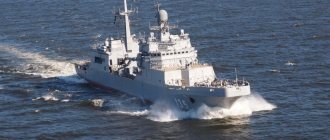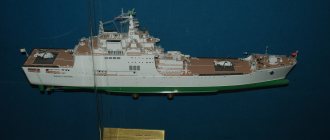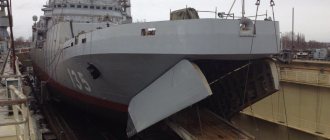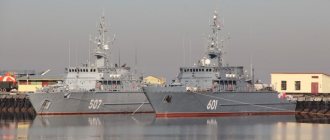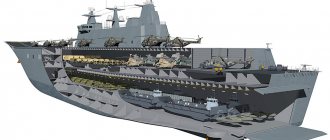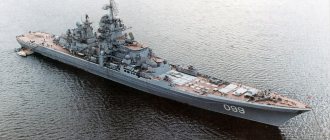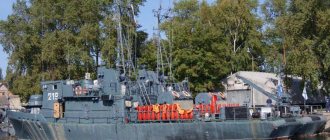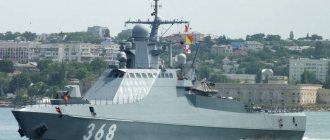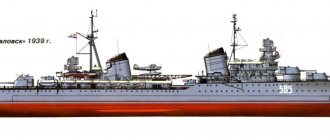In recent years, the Russian Federation's naval policy has undergone significant changes. Now it provides for the activities of the Navy to protect national interests in various areas of the World Ocean. The effectiveness of the actions of naval forces depends, among other things, on the capabilities of amphibious landings.
Naturally, landing in remote areas requires large-capacity transportation vehicles. These tasks in the Navy are traditionally assigned to large landing ships (LDCs). The newest representative of this class is the Project 11711 BDK Ivan Gren.
History of creation
At the end of the 90s, the Navy needed to replace the morally and physically outdated BDK of Project 1171. This series was built in 1964–1975. Now only four of these ships remain in service.
In 1998, the Nevskoye Design Bureau began developing the Project 11711 medium landing ship. The Navy was ready to order a series of six units. These ships were to operate in coastal and near sea zones (at a distance of up to 500 miles). In addition, their use in the “river-sea” mode was envisaged. To this end, the original design enabled the ship to pass through the locks and bridges of large rivers.
Obviously, the Navy placed such low demands on the project for financial reasons. In addition, there was a trend towards a decline in Russia's foreign policy influence. Therefore, the construction of ships in the ocean zone was considered irrelevant in the Navy.
Over time, the fleet command revised its requirements.
It was decided to increase the displacement of landing ships of the Ivan Gren type to 5000 tons or more. This made it possible to reclassify them into BDK. What was new in the project was a non-contact method of landing. It provides for a landing of troops along a pontoon crossing, directed from the landing ship to the shore.
During the six-year stage of work on the project, the requirements for the large landing craft were changed several times. In particular, the initial composition of weapons was reduced. Because of this, the ship lost the ability to strike the shore. It is believed that this was done to save money. But foreign analogues have similar weapons, although they are less limited in funds.
The slipway stage of construction of the large landing ship continued for another eight years. The reasons for the delay include a lack of funding and qualified specialists. At the same time, the plant was building a frigate for the Indian Navy. Apparently, the management of the enterprise gave priority to the export project.
The completion stage of the BDK Ivan Gren, including mooring tests and docking work, was carried out over another four years. During this period, the ship received a crew and tail number 135.
Tests - running and state tests - lasted almost a year. This delay is explained by the ship’s unsatisfactory reversing performance. According to some reports, this deficiency has not been completely eliminated. Reversing the positions of the main diesel engines on the second large landing ship of this project will help correct the situation. This rather complex operation will take several months. If successful, Ivan Gren will also undergo modifications.
The ceremonial transfer of the large landing ship "Ivan Gren" to the Navy took place on June 20, 2018.
The decision to build the next hull, the large landing ship “Petr Morgunov,” was made by the fleet command on September 1, 2014. The slipway stage of construction lasted from June 11, 2015 to May 26, 2022. Construction was carried out using mainly domestic components.
In 2015, the Navy command announced a decision to reduce the series from six to two units. The stop of the program may be due to the inconsistency of this project with the requirements. It is possible that the fleet gives priority to the creation of universal landing ships.
Leapfrog on the slipway
So what to build? After some thought, the Russian Navy command decided to abandon the logical idea of building an improved version of the Project 1174 landing craft: it was extremely expensive and difficult (remember, it was the 1990s). An alternative and relatively cheap option for building a troop transport in the hull of some kind of roller-rotor carrier in the interests of the Navy also did not arouse interest among the Fleet command. In general, to replace the old “paratroopers” they wanted to get new “paratroopers”, but for what specific tasks - it seems that no one really imagined this. Therefore, the terms of reference for the new ship turned out to be quite vague. From the series “Go there, I don’t know where, and build something there, I don’t know what.”
The design of the future BDK Project 11711 began according to the technical specifications of the Russian Navy in 1998 at the Nevsky Design Bureau in St. Petersburg. Since finances at that time were openly singing romances, at first there was talk of building something very small, like a new medium landing ship. But quite quickly, common sense won out, and apparently the means were found, so the project for a new landing ship was reformulated into the BDK project.
To speed up the design, it was decided to use for the new BDK the dimensions and hull contours of the well-proven Project 1171 BDK (built in 1964–1975). This limited the displacement of the future new BDK to 5,000 tons. In general, the Nevsky PKB produced a classic Soviet BDK. However, there were also differences: two (bow and stern) superstructures instead of one, a helicopter hangar, a pair of Ka-29 helicopters, as well as improved living conditions for the crew and troops.
facebook.com / Ministry of Defense of the Russian Federation
On December 23, 2004, at the shipbuilding plant in Kaliningrad, the first BDK of Project 11711, named Ivan Gren, was laid down. Then the leapfrog began. The Navy command with enviable consistency changed its views on the future use of the Gren, which led to constant adjustments to the project of the ship that had already begun construction.
For example, initially the BDK’s armament was supposed to consist of a 100-mm A-190M artillery mount, two Broadsword anti-aircraft artillery systems and two launchers of the A-215 Grad-M multiple launch rocket system. But then all this “splendor” shrank to one dual-automatic 30-mm automatic artillery mount “Duet”, a pair of 30-mm six-barreled automatic artillery mounts AK-630M, a pair of 14.5-mm pedestal machine gun mounts “Sting” and a complex of fired passive jammers.
In addition, it was initially assumed that the BDK would land equipment ashore “contactlessly.” That is, before reaching the shore, it will anchor, lower the bow ramp and build a pontoon bridge from it to the shore. Then the idea of “contactless” was abandoned. Then they returned to her. Then... Well, in general, you understand.
All this over and over again “cut” the project and the ship itself under construction “to the quick,” pushing back the completion date in every possible way. At the same time, stealth technologies began to be introduced into the design of the ship. At the same time, interruptions in financing began. At the same time, Russia began to think about purchasing universal Mistral economy-class landing ships from France, which called into question the need to complete the construction of the lead landing ship of Project 11711...
wikipedia.org/
Features of project 11711
The new landing craft was based on the developments of the 1171 Tapir project. The body of the predecessor was used with minor changes. This choice was facilitated by the successful experience of its operation. The proven technology for assembling the hull made it possible to reduce the costs of constructing the large landing ship.
The project received a new superstructure and a helicopter hangar.
The ship has a helipad, which provides take-off and landing of helicopters weighing up to 12 tons. The layout of the internal premises of the large landing craft has been changed in order to optimally move cargo. In addition, the project’s living conditions were improved (crew and landing quarters, gym).
During construction, new materials and technologies were used to reduce the radar signature of the ship. However, according to Western publications, this did not have the same effect as on NATO landing ships.
Project 11711 provides two ways to load landing equipment on board. The main one - under its own power along ramps and the auxiliary one - using a crane (16 tons) through the cargo hatch. The hatch also provides ventilation for the cargo hold. This makes it possible to warm up the engines of armored vehicles in advance of landing, safely for the health of the crews. Two boat cranes are designed to lift watercraft aboard the landing ship.
The landing will be carried out using a bow landing device (ramp) - directly onto the shore or into the water. If it is impossible for the large landing craft to get close to land, a non-contact landing method is used. In this case, a chain of pontoons is released from the cargo hold and connects the landing craft with the shore.
There is also the possibility of landing using two landing boats and two Ka-29 multi-purpose helicopters.
To house the latter, the BDK has a full-size hangar. Instead of two Ka-29s, the hangar may contain one attack Ka-52K.
The main power plant (GPP) includes two diesel reverse gear units DRRA3700. They are designed to rotate two fixed pitch screws. DRRA3700 includes:
- 16-cylinder V-shaped diesel engine 10D49. It is turbocharged and produces 5,200 hp;
- vibration-isolating couplings for connecting the diesel engine to the gearbox and the gearbox to the shaft line;
- reversible gearbox RRP6000;
- digital control unit "Purga-11". It also provides the ability to diagnose the installation and train personnel online. The ship is also equipped with two ADG-1000NK diesel generators with a power of 1000 kW each.
Project 11711 large landing ship “Ivan Gren” and its capabilities
The large landing ship “Ivan Gren” of Project 11711 (according to NATO codification Ivan Gren) will soon become the most modern large landing ship in the Russian fleet. The Ivan Gren BDK is designed for landing troops, transporting military equipment, as well as various equipment and cargo. In total, two ships of this project were laid down for the Russian Navy. The lead ship "Ivan Gren" is passing the final stage of state tests, the second large landing ship "Pyotr Morgunov" is preparing for launching. The Russian military abandoned the further construction of ships of this project in favor of creating even larger and more capacious ships of this class.
At the end of December 2022, the general director of the Baltic Shipbuilding Company, Eduard Efimov, told reporters that the large landing ship Ivan Gren had entered the final stage of state tests. Shortly before this, the newest Russian ship conducted its first firing and tested naval artillery in the Baltic Sea. It is a ship with a very difficult fate; it was laid down in Kaliningrad on December 23, 2004, but was launched only on May 18, 2012 and is still not included in the fleet. At the initial stage, the assembly of the ship was seriously complicated by unstable financing and problems at the enterprise itself.
At the same time, there is no doubt that they are waiting for a new ship in the fleet. Its introduction into the fleet will significantly expand the capabilities of the Russian Navy at sea and in remote regions of the planet. The ocean-going landing ship Ivan Gren of Project 11711 will be able to take on board up to 300 marines, as well as 13 main battle tanks (weighing up to 60 tons) or a choice of up to 36 armored personnel carriers/infantry fighting vehicles, the military equipment is located on the tank deck. The ship also has an indoor hangar and a landing pad for helicopters. It can carry on board up to two Ka-29 transport and combat helicopters, or Ka-27 search and rescue helicopters. If necessary, the Ka-52K Katran attack helicopter can also be accommodated on board.
Large landing ships of Project 11711 are a further development of the Soviet large landing ships of Project 1171 “Tapir”. The design of the ships of the new project was carried out by the Nevsky Design Bureau. The hull of Project 1171 ships was not taken as a basis by chance; it has proven itself well over decades of service in the Soviet and then Russian fleet. At the same time, most of the structures have undergone significant changes as part of the new project. The superstructure and interior of the landing ship were mainly redesigned. During the construction of the Ivan Gren landing craft, the most modern technologies were used, especially aimed at reducing visibility through the use of modern technical solutions and materials. In addition, increased attention was paid to the accommodation conditions for the ship's crew and paratroopers. A gym, a dining room, as well as more comfortable cockpits and cabins appeared on board the BDK.
Loading of military equipment onto a ship can be done either independently along ramps or using cranes. Loading of cargo and equipment into the troop compartment can be carried out through a four-leaf cargo hatch located in the upper deck using a crane with a lifting capacity of 16 tons. There are also two boat cranes on board for loading motor boats, lifeboats and equipment on board. Among other things, the ship's cargo hatch can be used for ventilation, removing exhaust gases from operating equipment from the space below deck (troop compartment). Ventilation of the troop compartment is very important, as it allows the transported equipment to warm up the engines, which is very important in conditions of low air temperatures. The exhaust gases of idling equipment quickly fill the landing hold, so ventilation through the upper cargo hatch is simply necessary, thanks to this the paratroopers will not be poisoned by the exhaust gases.
The main feature or “trick” of Project 11711 ships is the so-called non-contact method of landing troops on an unequipped coast. To do this, engineering pontoons can be pushed out into the water from the open bow doors, which, when coupled, form a bridge to the shore. This pontoon bridge is connected to the shore on which the landing is carried out, after which it is used to ferry heavy equipment and marines. This landing scheme allows you to maintain a distance between the landing craft and the shore, seriously reducing the risk of running aground.
The capabilities of the Ivan Gren BDK allow it to transport tanks, infantry fighting vehicles, armored personnel carriers, army trucks or towed artillery by sea over a distance of up to 3.5 thousand nautical miles (at a speed of 16 knots). Military equipment is transported on the so-called tank deck. Equipment can be loaded on board in different ways: using a deck or portal crane, or it can be driven on board the vessel under its own power through the stern ramp. In addition to military equipment, the BDK can transport various cargoes, including standard 20-foot sea containers. Standard 20-foot sea containers, among other things, can accommodate the Club-K missile system, which is a modification of the Caliber missile system. At the same time, it is unlikely that any missile systems will appear on board the Ivan Gren BDK, since countering enemy ships is not part of its direct tasks.
Light floating armored personnel carriers, infantry fighting vehicles and infantry fighting vehicles can be launched into the sea directly from the stern and bow of the ship, they are able to reach the shore on their own. Landing is possible when the sea state is up to 4 points. Thanks to its range, the Ivan Gren has the ability to land remotely, it is able to patrol a certain region for a month, and its navigation autonomy is exactly 30 days.
The total displacement of the landing ship is 5,000 tons, length - 120 meters, width - 16.5 meters, draft - 3.6 meters. The heart of the Ivan Gren BDK are two 16-cylinder V-shaped diesel engines 10D49 with gas turbine supercharging with a power of 5200 hp. The power plant capabilities allow the ship to accelerate to a maximum speed of 18 knots. The ship's crew consists of 100 people. The most modern BDKs in the Russian fleet before the advent of Project 11711 ships were Project 755 BDKs built in Poland. The Ivan Gren surpasses them in displacement - 5,000 tons versus 4,080 tons for Project 755 ships; in addition, the new Russian landing ship is 8 meters longer, 1.5 meters wider and sits 1.3 meters deeper in the water. Accordingly, its landing capabilities are higher.
As part of the work on the project and construction of the ship, its armament underwent changes. According to the initial design, one 76-mm AK-176M artillery mount, two Broadsword anti-aircraft artillery systems and two launchers of the A-215 Grad-M multiple launch rocket system were to appear on board the BDK. However, due to the fact that the concept of using the BDK of Project 11711 has undergone changes, as well as to save money and time to build the ship, in 2010 a decision was made to change the composition of the weapons, which today are of a purely defensive nature.
The armament of the BDK "Ivan Gren" is represented by one dual-automatic shipborne 30-mm automatic artillery mount AK-630M-2, two AK-630 mounts with a 5P-10-03 "Laska" fire control radar system, two 14.5-mm MPTU mounts " Sting”, as well as the KT-308-04 “Prosvet-M” complex of fired passive jammers, this complex protects the ship from enemy missiles.
The AK-630M-2 “Duet” is a modern dual-automatic 30 mm automatic artillery unit that provides an enormous rate of fire - up to 10,000 rounds per minute. Its main purpose is to provide missile defense for Navy ships in the near zone. First of all, it is designed to destroy anti-ship missiles and other types of guided weapons. The installation can also solve problems of destroying enemy aircraft, helicopters and UAVs, small surface and coastal targets. The effective firing range is 4000 meters.
The AK-630M-2 and AK-630 installations are built according to the scheme of a multi-barreled weapon (6 barrels each) with a rotating barrel block (the so-called Gatling scheme). The automation of Russian installations of this type operates using the energy of powder gases and, unlike foreign analogues (Phalanx CIWS and Goalkeeper), does not require external energy sources to rotate the barrel block. The AK-630M-2 “Duet” installation installed on the landing ship “Ivan Gren” was a further modernization of the AK-630M1-2 complex, from which it is visually distinguished by a turret that has received less radar signature.
In addition to rapid-fire artillery weapons, there are two large-caliber machine guns on board. This is the "Sting" MPTU - 14.5-mm naval pedestal machine gun mounts, which are designed to combat air, surface and coastal lightly armored targets. Large-caliber machine guns can effectively hit lightly armored targets at a range of up to 2000 meters and 1500 meters in height. To fire at air, surface and coastal targets, cartridges with the B-32 armor-piercing incendiary bullet, the BZT armor-piercing tracer bullet, and the MDZ instant-action incendiary bullet are used.
On the Internet and various media, one could come across statements that the new Russian large landing craft of Project 11711 are supposedly a kind of replacement for the Mistral-type universal landing dock ships built in France, but never transferred to the Russian Federation, but this is absolutely false. Firstly, the construction of the Ivan Gren BDK began long before the Ministry of Defense’s decision to purchase Mistrals from France, and secondly, the ships are difficult to compare even in their technical capabilities, mainly in size. It is incorrect to compare them due to the huge difference in displacement (more than 4 times), as well as the size of the aviation group (Mistrals can carry up to 16 light helicopters).
AK-630M-2 "Duet" - Russian shipborne dual-automatic 30-mm automatic artillery mount
It is more correct to compare the new Russian BDK Project 11711 with the Chinese ships Type 072-III (Yuting-II class), which are large tank landing ships that are the main landing craft in the PRC naval forces. With similar characteristics and dimensions, the Russian project has the advantage of having a full-fledged helicopter hangar on board.
Despite the fact that Russian sailors are not interested in the further acquisition of the Project 11711 BDK (information about this appeared in 2015), abandoning them in favor of larger ships of the new generation, it is too early to put an end to the future prospects of the Project 11711 BDK. Currently, the ship already has an export passport, so it can be promoted by Russia for export. This was reported by the Zvezda TV channel with reference to Sergei Vlasov, who is the general director of the Nevsky Design Bureau. Judging by the official catalog of the United Shipbuilding Corporation (USC), we are talking about project 11711E, which received a displacement increased to 6600 tons.
Larger landing craft that may appear in the Russian fleet in the future include ships of the Priboy project. As part of the Army-2015 forum, a model of universal landing ships of the Priboy project with a displacement of more than 14 thousand tons and a capacity of up to 500 paratroopers, 20-30 tanks or 60 units of various military equipment was presented for the first time. Among other things, these ships will be able to carry up to 8 Ka-27 or Ka-52K helicopters.
Sources of information: https://ria.ru/forces/20171229/1511888116.html https://tvzvezda.ru/news/opk/content/201708030944-qlqy.htm https://militaryarms.ru/voennaya-texnika/voennye -korabli/proekt-11711 Materials from open sources
Armament
Unlike its predecessors, the Project 11711 BDK has only anti-aircraft artillery systems (ZAK). These include the ZAK AK-630M-2 “Duet” in the forward part of the superstructure and two AK-630M in the aft part of the helicopter hangar. Their main purpose is to combat enemy anti-ship missiles.
Both complexes are based on an automatic six-barreled 30 mm AO-18 cannon.
It provides a firing range at air targets of up to 4000 m and a rate of fire of up to 5000 rounds per minute.
ZAK AK-630M-2 “Duet” is a dual-automatic unit with the ability to use one or two automatic weapons simultaneously. Its rate of fire reaches 10 thousand high/min. Firing control is carried out by the Vympel-AM2 system according to data from the MR-123AM2 radar.
The KM-11-1 laser target designator can also be used in conjunction with the LDM-1 “Cruiser” rangefinder.
Tactical and technical elements (TTE) of large landing ships
| Project | 11711 | 1171 | 775M | Type 072-III (China) |
| Year of issue | 2018 | 1964–1975 | 1974–1991 | 2003–2005 |
| Displacement – standard – full | 5000* | 3040 4360 | 2768 4080 | 3430 4170 |
| Dimensions – length – width – draft | 120 6,5 3,6 | 113 15,6 4,15(6,15) | 112,5 15 3,7 | 119,5 16,4 2,8 |
| Speed | 18 | 16 | 17,5 | 18 |
| Range | 3500 (at speed 16 knots) | 4800 (12 kt.) | 3500 (16 kt.) 4000 (12 kt.) | 3000 (14 kt.) |
| Autonomy, days. | 30 | 20 | 30 | 30 |
| Crew, people (officers) | 100 | 69 55 (5) | 87(8) | 104 |
| GEM | 2 D × 5200 hp | 2 D × 4500 hp | 2 D × 9600 hp | 2 D × 4745 hp |
| Armament | 1 30-mm ZAK AK-630M-2 “Duet”; 2x6 30mm AK-630; 2 × 14.5 mm MTPU “Sting” | 1 × 2 57 mm ZIF-31B automatic guns, 2 × 2 25 mm 2M-3M assault rifles; 2 MANPADS Strela-3 (24 missiles); 2x40 MLRS A-215 "Grad-M" (160 NURS) | 1 AK-176; 2 × AK-630M; 2 × MLRS A-215 "Grad-M" (320 NURS); 2 × Strela-3 MANPADS | 1×2 37 mm Type 76F gun; MANPADS |
| Landing capacity: – MBT / armored personnel carrier – paratroopers | 13 / 36 300 | 20 / 47 440 | 10 /12 340 | 10/n.d. 120 |
| Aviation | 2 Ka-29 / 1 Ka-52K "Katran" | No | No | vert. area |
| Built | 1 | 14 | 28 | 9 |
| In service | 1 | 4 | 16 | 9 |
* The Western press indicates the total displacement of the project to 6000–6600 tons.
The large landing craft of the Ivan Gren type differ from their “classmates” in having a larger displacement. However, this does not significantly affect its landing capabilities. The indicated number of paratroopers (300 people) does not correspond to either a company (as for the Type 072-III project) or a battalion (Project 1171).
Presumably, the Ivan Gren BDK is still designed to land a marine battalion (more than 400 people). Or it will be able to land a full-fledged landing force only together with other landing ships.
In terms of its armament, the Ivan Gren BDK is significantly weaker than its domestic counterparts, but is close to foreign ones.
Battle path
Due to the short service life of the BDK Ivan Gren, it was possible to participate in only two naval parades in 2022 and 2018.
The prospects of Project 11711 can be assessed based on its advantages and disadvantages.
The new project is not fundamentally different from its predecessors in terms of its technical characteristics. The main advantages of the Ivan Gren-type landing craft are:
- helicopter hangar;
- means for contactless landing;
- improved habitability.
All this could be achieved as part of the modernization of existing BDK projects. As for aviation capabilities, the Ivan Gren cannot compare with an amphibious helicopter carrier. The ability to transport standard containers cannot be seriously considered an advantage. Container ships have long been invented for this purpose.
The disadvantages of Project 11711 include:
- obsolescence;
- inability to demagnetize the housing in accordance with the design specifications;
- insufficient strength of the hull structure;
- reverse problems.
As a result, the Northern (121 landing ship brigade) and the Black Sea fleets will each receive one new landing ship. This will be a minor (by one unit) gain, and not a qualitative leap in the area of the Navy’s amphibious capabilities.
Meanwhile, management is considering the export prospects of landing ships of Project 11711. But the foreign market puts forward increased demands on the large landing ship:
- total displacement – at least 6000 tons;
- landing capacity - up to 500 marines;
- equipping the ship with a docking chamber for an air-cushion landing craft.
To the tenacity of the brave...
It was originally assumed that the Navy would receive the Gren back in 2008. In fact, the new BDK was launched and its further completion began only on May 18, 2012.
True, the situation was somewhat brightened up by the fact that in 2010 it received a contract for the construction of another large landing craft of Project 11711. The plant received the contract, but... But then the famous events of 2014 happened in Crimea, which came back to haunt, firstly, the refusal of Paris to give to Moscow the Mistrals built for it; secondly, the refusal of a number of Western suppliers to ship the equipment Russia needs for Gren.
On the one hand, the loss of the Mistrals once again raised the topic of the speedy commissioning of the Gren for the Russian Navy. On the other hand, the solution to the problems that arose with import substitution again shifted to the right the deadlines for the readiness of the lead BDK of Project 11711 and did not allow the laying down of the second BDK of the same project to begin.
By the summer of 2015, the task of adapting the 11711 project to domestic equipment was generally solved. At the same time, the Syrian Express was gaining momentum, so that each large landing craft for the Russian Navy was literally worth its weight in gold. Together, these circumstances contributed to the fact that on June 11, 2015, the second large landing ship of Project 11711 was finally laid down. It was named “Petr Morgunov”.
It was assumed that the Russian Navy would receive 6 BDKs of Project 11711. However, the not very joyful picture of the stuck ship, which at the time of the laying of the Morgunov was not only still being completed, but also continued to be remodeled, diminished naval optimism regarding this project. As a result, a decision was announced to reduce the series of new BDKs to the Gren and Morgunov “due to the decision to create larger ships of a new generation.” According to representatives of the Russian Ministry of Defense, the displacement of the new generation large landing craft will exceed 14,000 tons...
facebook.com / United Shipbuilding Corporation
To put it simply, three years ago the command of the Russian Navy returned to the point from which Project 11771 started in 1998. The fleet needed an improved version of the Soviet BDK Project 1174, capable of “over-the-horizon landing” and “vertical coverage”!
Here's something else for those who don't understand. Reducing the series from six ships to two did not significantly reduce the cost of building the Project 11711 large landing ship, leaving it very high.
But let's move on.
While the Krylov State Research Center, encouraged by the return of fashion for large landing craft helicopter carriers in the Russian Navy, was organizing presentations of desktop models of domestic universal landing ships of the future, held under the codes “Priboy” and “Avalanche,” the “Gren” was being completed on the “Yantar” and the “Morgunova” was being built. After the fantastic funds and efforts spent since 1998 on the design and creation of the large landing craft of Project 11771, the Fleet simply had to get at least something!.. Even if this “something” had already been relegated to the category of unpromising projects by reducing the series to two ships.
On June 21, 2016, “Ivan Gren” was finally able to go to the factory, and then to the state tests. They were, to put it mildly, difficult. This is clear from the fact that the acceptance certificate for the completion of state tests of Ivan Gren was signed only on June 2, 2022.
According to information not officially confirmed, the Gren experienced problems with stability, an insufficient field of fire for gun mounts, demagnetization, controllability when moving in reverse... The ship returned to the ship, went back for testing, discovered new "shoals", again set course for the plant... In a word , we sing a song to the perseverance of the brave.
Then the customer finally accepted the ship.
facebook.com / United Shipbuilding Corporation
Place of the Ivan Gren-class landing craft in the Russian Navy
The process and result of the work to create this project is an example of an ill-considered approach to fleet construction. There was a simple replenishment of obsolete ships with slightly modernized analogues.
Obviously, the need to operate in the Ocean zone requires a qualitative increase in the combat capabilities of the fleet. Half measures in the form of a large landing ship “Ivan Gren” or a “mosquito” fleet with “Caliber” missiles are a waste of money. A promising direction, for example, could be the construction of universal landing ships of the Priboy project.
The history of the appearance of the BDK project 11711
Since most modern wars are local, the armies of large countries must be highly mobile and professional. This is what served as the basis for the development of a new type of warship by the Russian Navy. Since the role of the navy currently includes landing troops, Russia urgently needed landing ships capable of transporting a large number of marines, along with their combat vehicles.
All the old landing craft that were made back in the USSR could not accommodate a sufficient number of marines, so in 1998 the Nevsky Design Bureau received technical specifications for the development of ships of this type. Initially, the special landing craft was supposed to be small. It was supposed to be used in the Black and Baltic Seas.
Soon, plans to create a landing ship were significantly adjusted. The creation of a small ship was considered inappropriate to the modern concept of warfare, so it was decided to significantly increase the displacement of the future warship. The new plan envisaged the creation of a large landing ship that could solve military problems anywhere in the world's oceans.
Although the new plan was accepted, significant changes had to be made 3 more times during the development of the project. Design development continued for 6 years. Ultimately, the project became known as Project 11711, and the large landing craft, according to the new design development, was supposed to have the following characteristics:
- The ship's displacement was increased to 5,000 tons, which significantly increased the usable area for accommodating personnel and specialized military equipment;
- The characteristics of the landing ship allowed the ship to move freely anywhere in the world's oceans;
- The vessel was equipped with the most modern loading and unloading facilities;
- Its deck could accommodate two helicopters and a whole set of various weapons.
In addition, the new ship included space to accommodate a number of loading and unloading machines and special sea pontoons.
